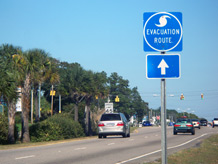
Scientists are researching the impact of the mega storm which saw residents flee from New York
American academic to assess impact of Frankenstorm
An American scientist at the University of Exeter is assessing the impact of the mega storm resulting from Hurricane Sandy as it rips through his homeland.
The eye of the storm is currently over the Christina River Basin Critical Zone Observatory, in south-eastern Pennsylvania, which University academics frequently visit as part of their research.
The $4.4 million Observatory supplies samples which can be uniquely tested at Exeter, using specialist equipment that can track the sources and rates of erosion and impacts to rivers due to storms.
Professor Rolf Aalto, a Geography expert in rivers and erosion, is monitoring the progress of the storm for many reasons close to his heart. The top priority is the safety of family and friends living in Pennsylvania and New York and other areas affected by the ferocious weather. But it will also offer the opportunity to study first-hand the effects of the type of storm which can alter the landscape forever.
Prof Aalto said the Observatory was directly in the eye of the storm today. He said: “For personal reasons, this storm is very worrying, and for the sake of my family and friends I hope it passes quickly. Whatever happens, Exeter will help to document the impact that a storm of this magnitude has on the evolution of the landscape. It’s extremely rare for storms to combine with other storms as this one has done. There’s little historical precedent. We have to know what happens next, to the people and the landscape in which they live.”
Prof Aalto’s work looks at how upland soils and rivers are shaped over centuries, including the impact of humans and how landscapes respond to extreme weather. “Large storms like this are documented mainly as historical records. As scientists we’re not normally around to document first-hand the detailed response to the storm and impacts on the landscape. We spend a lot of time wondering about storms after the fact, but have limited data to examine how they actually play out real time.”
Instruments at the Observatory have been programmed to collect regular samples from surrounding waterways. Prof Aalto and Exeter postgraduate researcher Julia Marquard will measure the samples and examine the data to determine how such storms effect landscape change. They are studying whether humans or extreme weather have the biggest impact in determining the erosion of soils and downstream impact of the resulting sediment on rivers. As part of the research, Julia is developing new techniques to assess the rates and impacts of erosion, including individual storms, over years, decades, and even centuries.
Prof Aalto said: “Hurricane Sandy presents an opportunity to investigate the role of mega storms, and whether they account for the majority of change in land around waterways. We will be able to examine what sediment and other material has been moved amidst this huge amount of water. We don’t properly understand the importance of these huge storms, yet long-term climate models are predicting an increasingly stormy future.”
The Observatory is funded by the National Science Foundation and Julia Marquard’s research by a USA Philanthropist.
Date: 30 October 2012
